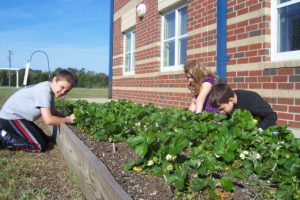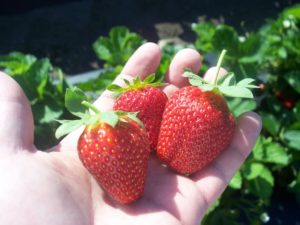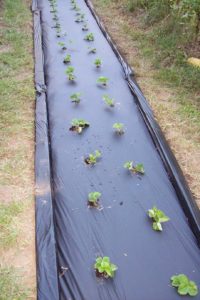Get Growing: Strawberries in the Garden
go.ncsu.edu/readext?555471
en Español / em Português
El inglés es el idioma de control de esta página. En la medida en que haya algún conflicto entre la traducción al inglés y la traducción, el inglés prevalece.
Al hacer clic en el enlace de traducción se activa un servicio de traducción gratuito para convertir la página al español. Al igual que con cualquier traducción por Internet, la conversión no es sensible al contexto y puede que no traduzca el texto en su significado original. NC State Extension no garantiza la exactitud del texto traducido. Por favor, tenga en cuenta que algunas aplicaciones y/o servicios pueden no funcionar como se espera cuando se traducen.
Português
Inglês é o idioma de controle desta página. Na medida que haja algum conflito entre o texto original em Inglês e a tradução, o Inglês prevalece.
Ao clicar no link de tradução, um serviço gratuito de tradução será ativado para converter a página para o Português. Como em qualquer tradução pela internet, a conversão não é sensivel ao contexto e pode não ocorrer a tradução para o significado orginal. O serviço de Extensão da Carolina do Norte (NC State Extension) não garante a exatidão do texto traduzido. Por favor, observe que algumas funções ou serviços podem não funcionar como esperado após a tradução.
English
English is the controlling language of this page. To the extent there is any conflict between the English text and the translation, English controls.
Clicking on the translation link activates a free translation service to convert the page to Spanish. As with any Internet translation, the conversion is not context-sensitive and may not translate the text to its original meaning. NC State Extension does not guarantee the accuracy of the translated text. Please note that some applications and/or services may not function as expected when translated.
Collapse ▲Get Growing: Strawberries in the Garden
I cannot think of a more joyful spring garden moment than picking fresh strawberries in the garden with kids. Kids race to find strawberry fruits tucked under the dew-drenched leaves and the treasure is a juicy, sweet and tart surprise. Spring-bearing strawberries actually begin in the fall with planting in mid-September through early October in the Piedmont and Coastal Plain, a little earlier in the mountains.

To get started, consider the following:
Locating a Good Garden Site
Light: The garden needs at least 8 hours of sunlight each day. Avoid sites with tall trees or buildings to their south due to the low angle of the sun in the winter.
Soil: The garden must have well-drained soil. If the site has poor soil quality, adding compost will improve soil structure and nutrient availability.
A Raised Garden Bed: Raised beds can be a way to provide a good growing medium for the strawberries. Beds should be at least 6 to 8 inches deep. There are a number of raised bed designs.

Raised beds can keep the soil dry and easy to access
Space: A single bed measuring 3 feet by 15 feet can contain 30 plants. Be sure to include room for pathways to walk and work around the beds. If a school has limited space, strawberries grow well in many different types of containers. Consider using one- to five-gallon pots or even growing strawberries directly in a bag of soil.
Water: Make sure that there is access to potable water to irrigate the plants.
Strawberry Plants
Strawberries should be planted as young plants (the easiest type to use are called “plug plants”) in the early fall (Fig. 1). They will grow throughout the fall, winter, and spring with fruit ready to harvest by April or May. Choose an appropriate variety. ‘Chandler’ variety plants will likely perform best in most parts of North Carolina. Other possible varieties include ‘Camarosa’, ‘Festival’, and ‘Sweet Charlie’.

Black Plastic Mulch
Strawberry growers in North Carolina have a strawberry production system that uses a special black plastic to cover the soil. Made for farming, this plastic is very thin yet strong and flexible. The flexibility of the plastic allows you to gently stretch it over the soil without tearing. The black plastic warms the soil, acts as a mulch to suppress weeds and conserve water, and limits disease. Black plastic is usually 5 feet wide and comes in rolls. A strawberry farmer in your area may be willing to provide the small amount of plastic you need for minimal or no cost. Often growers have leftover lengths they might not need. It might also be obtained through farm supply stores or the NC Strawberry Association.

Strawberries can be planted in a staggered pattern to maximize space
Row Covers
Row covers are made from non-woven, spun-bonded material (the same as is used for facings in clothing). Placed over the strawberry plants, the covers will let in light and rain but help keep plants warmer in cold weather, especially if they are put on early in the day so the sun’s heat can be trapped under them. Part of their effectiveness comes from keeping off cold, harsh winds. Row covers can be obtained through your farmer connection, the NC Strawberry Association, a local farm supply store, or an online garden supply company. Weights of 1.0 to 1.5 oz./square foot are recommended.
For a complete guide to growing Strawberries at home or in your school, download our resource, “Teaching from the Garden: Growing a Schoolyard Strawberry Garden.”


